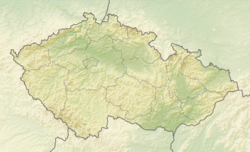Vělopolí
Vělopolí
Wielopole | |
|---|---|
 Municipal office | |
| Coordinates: 49°42′1″N 18°34′15″E / 49.70028°N 18.57083°E | |
| Country | |
| Region | Moravian-Silesian |
| District | Frýdek-Místek |
| First mentioned | 1448 |
| Area | |
• Total | 2.99 km2 (1.15 sq mi) |
| Elevation | 370 m (1,210 ft) |
| Population (2024-01-01)[1] | |
• Total | 295 |
| • Density | 99/km2 (260/sq mi) |
| Time zone | UTC+1 (CET) |
| • Summer (DST) | UTC+2 (CEST) |
| Postal code | 739 59 |
| Website | www |
Vělopolí (Polish: ⓘ) is a municipality and village in Frýdek-Místek District in the Moravian-Silesian Region of the Czech Republic. It has about 300 inhabitants. The municipality has a significant Polish minority.
Etymology
[edit]The name is of topographic origins, meaning "large field" in Slavic languages (wiele pole in Polish, velké pole in Czech). It was first written as Wele Pole.[2]
Geography
[edit]Vělopolí is located about 14 kilometres (9 mi) east of Frýdek-Místek and 22 km (14 mi) southeast of Ostrava. It lies in the Moravian-Silesian Foothills in the historical region of Cieszyn Silesia.
History
[edit]
The first written mention of Vělopolí is from 1448. Politically it belonged then to the Duchy of Teschen.[3][4]
After Revolutions of 1848 in the Austrian Empire a modern municipal division was introduced in the re-established Austrian Silesia. The village as a municipality was subscribed to the political and legal district of Cieszyn. According to the censuses conducted in 1880–1910 the population of the municipality dropped from 327 in 1880 to 306 in 1910 with all the inhabitants being native Polish-speakers. In terms of religion in 1910 the majority were Protestants (88.2%), followed by Roman Catholics (11.8%).[5]
After World War I, Polish–Czechoslovak War and the division of Cieszyn Silesia in 1920, Vělopolí became a part of Czechoslovakia. Following the Munich Agreement, in October 1938 together with the Trans-Olza region it was annexed by Poland, administratively adjoined to Cieszyn County of Silesian Voivodeship.[6] It was then annexed by Nazi Germany at the beginning of World War II. After the war it was restored to Czechoslovakia.
Demographics
[edit]Polish minority makes up 20.1% of the population.[7]
|
|
| ||||||||||||||||||||||||||||||||||||||||||||||||||||||
| Source: Censuses[8][9] | ||||||||||||||||||||||||||||||||||||||||||||||||||||||||
Sights
[edit]Vělopolí is poor in monuments. The only cultural monuments are a homestead from 1887 and a set of statues from the first half of the 19th century, which were originally in the park of the Hnojník Castle.[10]
References
[edit]- ^ "Population of Municipalities – 1 January 2024". Czech Statistical Office. 17 May 2024.
- ^ Mrózek, Robert (1984). Nazwy miejscowe dawnego Śląska Cieszyńskiego [Local names of former Cieszyn Silesia] (in Polish). Katowice: Uniwersytet Śląski w Katowicach. p. 182. ISSN 0208-6336.
- ^ "Historie obce" (in Czech). Obec Vělopolí. Retrieved 16 March 2022.
- ^ Panic, Idzi (2015). Śląsk Cieszyński w średniowieczu (do 1528) [Cieszyn Silesia in Middle Ages (until 1528)] (PDF) (in Polish). Cieszyn: Starostwo Powiatowe w Cieszynie. p. 313. ISBN 978-83-935147-8-6.
- ^ Piątkowski, Kazimierz (1918). Stosunki narodowościowe w Księstwie Cieszyńskiem (in Polish). Cieszyn: Macierz Szkolna Księstwa Cieszyńskiego. pp. 266, 284.
- ^ "Ustawa z dnia 27 października 1938 r. o podziale administracyjnym i tymczasowej organizacji administracji na obszarze Ziem Odzyskanych Śląska Cieszyńskiego". Dziennik Ustaw Śląskich (in Polish). 18/1938, poz. 35. Katowice. 31 October 1938. Retrieved 1 July 2014.
- ^ "Population Census 2021: Population by selected ethnicity". Public database. Czech Statistical Office. 27 March 2021.
- ^ "Historický lexikon obcí České republiky 1869–2011" (in Czech). Czech Statistical Office. 21 December 2015.
- ^ "Population Census 2021: Population by sex". Public Database. Czech Statistical Office. 27 March 2021.
- ^ "Výsledky vyhledávání: Kulturní památky, obec Vělopolí". Ústřední seznam kulturních památek (in Czech). National Heritage Institute. Retrieved 21 June 2024.




